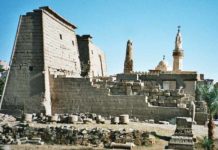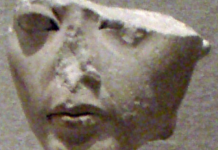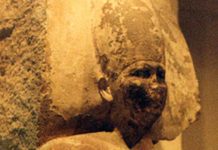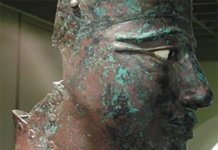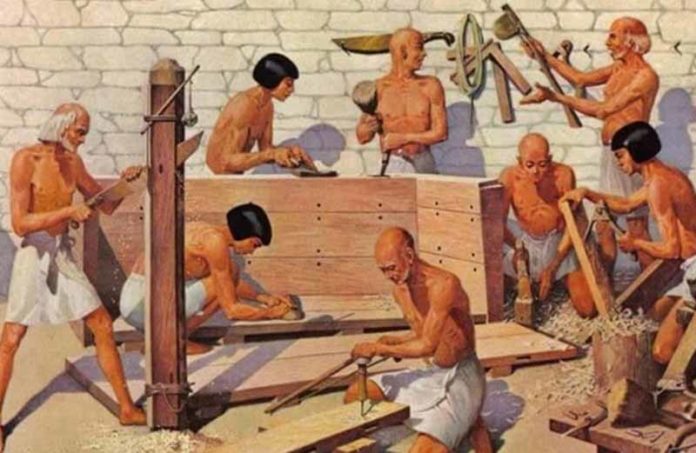
The workmen who built the tombs of the New Kingdom Kings and Queens, were not ordinary laborers. Some, like Sennedjem, had their own tombs also built in the surrounding hills.
Artisan Laborers in the Valley of the Kings
These were artisans, quarrymen, sculptors, and painters, responsible for making the suitable burial places for their kings. They had built and painted the beautiful tombs of Tutmosis III and Ramesses I and many other kings in the Valley.
Salary of the Artisans
The workmen were paid in grain, on average four sacks of emmer wheat per month, enough to feed sixteen people. They also received 1.5 sacks of barley daily, in order to make beer. This salary was generous at that time. They also received additional beer and bread in order to make offerings at the local temples. To supplement their diet, the workers also received fish, vegetables, and fruits. Water was brought from the Nile by servants for their well and storage jars. Their clothing, wood, and pottery were provided to them.
20th Dynasty Conditions in Egypt
The Nile was flooding on time, and the fish and other foods were delivered regularly to the workmen. Yet, in the second month of the 29th regnal year of Ramesses III, a junior scribe wrote to the Vizier’s office that grain was missing from their rations. Five-hundred people in the village needed to be fed.
Just one of the grain storehouses at the temple complex at Thebes alone could have sufficed to feed the entire village of the workmen for ten years. Perhaps the many building programs taken on by Ramesses III had depleted the grain reserves. But at least one small temple alone lost more than 90% of its northern grain reserves to corrupt officials, and this embezzlement had gone undetected for ten years.
Labor Walk-Outs
When twenty straight days went by, with no wheat rations being distributed, the workmen left the village and walked to the mortuary temple of Horemheb, which stood next to the temple at Medinet Habu, hoping to find wheat from the temple reserves. Two days later, 46 sacks were delivered-an insufficient amount.
Three months later, they had still received no rations. On day ten of their work-week, they left their village and went to Medinet Habu, which also served as the administrative center for Thebes. For the ancient Egyptians, a week consisted of ten days, not seven, so day ten was in fact their day of rest. Leaving their administrative station administrative station, i.e. the village and the Valle, was an unprecedented event, and frightened the bureaucracy. The workmen were not permitted to remain at Medinet Habu, so they continued north to the temple of Tutmosis III, and began what would be called today a sit-down strike. But they returned to their homes at night.
The next day, they repeated their walk-out, this time gathering at the Ramesseum. To appease the workers, they were given 55 little cakes. Although they had again returned to their homes for the night, on the third day, the workers again gathered at the Ramesseum, this time entering the actual temple itself. They were then given rations—for the preceding month. Their pay for the current month was still in arrears.
Medjay Supports Workers
Security was provided over the village and the Valley by a group of Nubian soldier-policemen called Medjay. Their chief encouraged the workmen and families and go to the temple of Sety I at Qurna, the southernmost of the region’s temples. Perhaps the earlier temples were now barred to the workmen. So for four more days, the workmen gathered at the temple, closing down the village. This time they got action, as the rations were finally delivered, everything that was due them.
Strikes Repeated
In the following month, the workers had once again not been paid their owed amount. This time the workers threatened to violate the very tombs for which they worked so hard. The Vizier met with them and attempted to explain, not very clearly, that there was no grain to give them. He managed to deliver half-rations to the workers, four days later. More than a week later, they gathered at the temple of Merenptah and since the governor of Thebes was nearby, addressed their grievances to him. He did no better, and in fact, showed evidence of misappropriating some compensation rightly owed them.
These strikes continued throughout the reigns of the succeeding Ramesses Kings, with a brief peace between Ramesses IV and IX, only to begin again until the reign of Ramesse XI. After his reign, kings were no longer buried in the Valley. The workmen left, and the village found other uses.
Sources:
- Romer, J. (1984) Ancient Lives: Daily Life in Egypt of the Pharaohs. Holt, Rinehart & Winston
- Vernus, P. (2003) Affairs and Scandals in Ancient Egypt. Cornell University Press



